- Top page
- > What is Unzen?
- > History of Unzen
Edo era from ancient
- A.D.
- Historiography
- 88
- Unzensan and Shimabara appear on documents
- 701
- Monk Gyoki starts his own temple, also worshipping Shimengu shrine, names the mountain Unzensan.
- 713
- In the "Hizen Fudoki" the origins of the name "Takaku no Kori (Takaki County)" and hot springs are described
- 749
- Gyoki Bosatsu dies
- 778
- Daijyoin Manmyoji temple fire
- 790
- Kobo Daishi climbs Unzensan, praises as a spiritual land (legend)
- 931
- Second Daijyoin Manmyoji temple fire, destroyed (Unzensan engi)
- 1115
- 300 monks in Seto Ishiwara, 700 in Bessho, 1000 monks in total (Origins of Unzensan)
- 1571
- Daijyoin Manmyoji warrior monks start a conflict, temple and monks burned knowns a the "Rebellion of Hakujaku" (Jashu handanki)
- 1625
- By order of Matsukura Bungonokami Shigemasa and the Tokugawa Shogunate, Christians were to be strictly oppressed. (It has been said that during this year, 10 Christians were thrown into the hot springs fire pit)
- 1627
- Christian oppression becomes even more severe. From this year until 1630, Christians were taken to the hot springs and tortured until they converted, called "Yama iri".
- 1637
- Shimabara rebellion occurs. December 3rd, the leader of the rebellion army Amakusa Shiro Tokisada enters Hara caste, total rebel forces approximately 23,800
- 1638
- February 28th, food and ammunition is depleted, resulting in defeat. Rebellion resolved. Total of 35,000 young and old dead
- 1640
- Ichidai Shakado constructed on the ruins of Daijyoin, named Ichijyoin.
- 1653
- Kato Zenzaemon opens a hot water reservoir and names it Enrekitou (beginning of communal bathhouses)
- 1657
- Near the Mt. Fugendake hatoana, lava erupts towards the north (Meireki eruption)
- 1663
- March, the south side of Mt. Fugendake erupts (Eruption of 1663)
- 1672
- Kato Zenzaemon the 2nd digs a hot springs reservoir in Furuyu, becomes new hot spring manager.
- 1690
- Englebert Kaempfer arrives at Nagasaki and teaches western medicine. Written during his stay, History of Japan mentions the name Unzen. (Introduces to Europe)
- 1693
- To protect the hot springs, a mountain keeper is placed, and on April 1st, signs are put up at the 4 entrances to the grounds
- 1731
- Bath is constructed at Kojigoku hot spring. Named the South Hot Spring, with the Furuyu dug in 1653 named the North Hot Spring.
- 1738
- Killing prohibition sign put up in Mt. Fugendake
- 1755
- Gomado temple constructed at the hot springs
- 1775
- To protect Unzensan, The Shimabara feudal lord places a mountain peacemaker
- 1792
- Mayuyama collapses as a result of a large earthquake, massive tsunami occurrs (1792 Unzen earthquake and tsunami)
- 1792
- Hot springs Fudanohara paddy construction complete
- 1823
- Philipp Franz Balthasar von Siebold authors Nippon, and includes the name Unzen in his works. Introduces as "Unzen Take" to Europe.
- 1853
- Yoshida Shoin enters Kojigoku
- 1855
- Takashima coal mine engineer Brown climbs Unzen, which foreigners were prohibited from climbing, stays at Uedaya.
- 1867
- Two Englishmen climb the mountain unauthorized, captured at Kojigoku and escorted to Nagasaki
Showa initial from Meiji
- A.D.
- Historiography
- 1870
- Seven American officers with an interpreter and a cook, sojourn at Yumoto Ryokan (Current Yumoto Hotel)
- 1878
- Developed Shinyu hot springs. Sheep breeding begins at Unzen. Aside from Japanese-only baths, single-person "westerner baths" made, segregated bathing results in increased foreigner guests
- 1883
- Shimoda hotel constructed in purely western style. Midori-ya hotel renews facilities for foreigners.
- 1890
- Foreign journal the Shanghai North China Daily News introduces Unzen. Increased summer retreat customers from overseas
- 1891
- Trial production of hot springs rice crackers
- 1893
- Shinyu's Kamenoya inn (current Shinyu Hotel) becomes foreigner-only hotel.
- 1895
- After Sino-Japanese war, Russian guests from Harbin and Vladivostok increase
- 1899
- Seasonal (summer) telegraph handling office established. 6 years later becomes 2nd class post office
- 1905
- Dr. Erwin Bälz from Germany climbs mountain, advises prefectural authorities to establish prefectural resort hot spring park
- 1911
- April, Japan's first prefectural management Unzen Park opened (Hot spring park regulatory rules established)
August, prefectural Unzen park office established (Leased housing). Obama-Unzen road improvement, completed. Cars now running
Electric lamps light up in Unzen and Obama
- 1913
- Prefectural golf course (Ikenohara, 9 hole) established. Prefectural tennis courts established (Yunosato)
- 1916
- Chijiwa-Unzen motorway completed
- 1918
- July, Japan Tourist Bureau (JTB) establishes summer season hot springs sub branch office within park office
- 1920
- Yoshii Isamu and Saito Mokichi come to Unzen
- 1921
- August, First International Tennis Tournament held
- 1922
- Route bus operates connecting Unzen and Obama. Motorway completes between Shimabara and Unzen
- 1923
- January 1st, weather station established on Mt. Kinugasa. Streetlamps set up at Unzen.
- 1924
- Indian poet Rabindranath Tagore comes to Unzen.
- 1925
- Prince Chichibu climbs Mt. Fugendake
- 1927
- Mt. Unzen comes in 1st place for the mountain section of the "New Eight Views of Japan". More than 20,000 foreign guests
Chiang Kai-Shek visits Unzen. Prince Takamatsu visits Unzen.
- 1928
- Mt. Unzen is designated by the Historical Spot, Scenic Beauty and Natural Monument Preservation Law at the time as a place of scenic beauty.
- 1929
- June, Cold water pool constructed at Bessho. Tokutomi Soho visits Unzen.
- 1930
- August, Unzen International Tourism Association established
- 1931
- Unzen Horseback Riding Association founded *Manchurian Incident occurs
- 1933
- January, Unzen Longbow field completed
July, Shirakumo pond camping ground opened
Princesses Higashifushimi and Takamatsu visit Unzen
- 1934
- March 16th, designated as a national park
The name Onsen park is officially changed to Unzen park
Prefectural busses operate between Nagasaki and Unzen (Prefectural busses launched)
Becomes 2nd site for the International tourism expo
- 1935
- Kitahara Hakushu visits Unzen
- 1936
- Nita automobile toll road completed *February 26 incident occurs
- 1937
- National Park Designation Comemmorative Unzen Memorial Hall completed
Mt. Unzen weather station established
- 1941
- * Pacific war begins
- 1942
- Prince Mikasa visits Unzen
Current from the post-war
- A.D.
- Historiography
- 1946
- US occupation forces requisition prefectural land (golf course) and hotels
- 1949
- His Majesty the Emperor visits
- 1950
- 6th Japan UNESCO convention held
Requisition of golf course, tennis courts, and hotels called off
- 1951
- International golf tournament and international tennis tournament held
- 1952
- Mt. Unzen and Mt. Fuji designated by the Cultural Protection Act as a "Special Place of Scenic Beauty"
- 1954
- Filming for movie Kimi no Na wa begins
National park designation 20th anniversary commemoration ceremony held
- 1955
- Bessho's swimming pool closed
- 1956
- Japan joins United Nations
Designated as a national recreation area
Combined with the Amakusa islands, becomes Unzen Amakusa national park
- 1957
- Obama-Unzen toll road completed
Nita pass-Mt. Myokendake ropeway completed
Collective facilities district zone and plan announced
- 1958
- Entertainment hall removed due to aging
- 1960
- Unzen-Shimabara toll road completed
- 1961
- Emperor and Empress visit Unzen
Comprehensive national development plan announced
- 1963
- Prefectural International Tourism Hall completed
Tourism Basic Law established
Prefectural busses begin direct service between Nagasaki Airport and Unzen
- 1964
- National park designation 30th anniversary commemoration ceremony and Nagasaki Prefecture Natural Park tournament held
Kyushu International Sightseeing Bus (Ltd.) begins long-distance bus service between Nagasaki, Unzen, Kumamoto, and Beppu.
Tokyo Olympics held
- 1965
- Unzen Beautifying Association established
Prince and Princess Mikasa visit Unzen
- 1966
- Filming for TV program "Kimi no Na wa" begins
- 1967
- Pollution Countermeasures Basic Law enacted
- 1969
- The Crown Prince visits Unzen
Emperor and Empress visit Unzen
New comprehensive national development plan announced
- 1970
- Japan World Expo held
- 1971
- 13th National Park tournament held, Prince and Princess Hitachi welcomed
- 1973
- Archery field removed due to aging
Obama-Unzen-Shimabara toll road becomes free
The first oil shock occurs
- 1974
- National Land Use Law Enacted
National park designation 40th anniversary commemorative event held
- 1976
- Sister treaty signed with Banff National Park in Canada
TV drama "Hana Bouro" (original work: Hanato Kobako) goes on air
- 1977
- Prince Hiro visits Unzen
Memorial hall removed due to aging
3rd comprehensive national development plan announced
- 1978
- 1st Festival Unzen held
- 1981
- Catholic Unzen Church completed, dedication ceremony held
- 1982
- 1st childrens Natural Park tournament "Play Barefoot Unzen" held
- 1983
- Unzen plan 50 announced
- 1985
- Unzen Memorial Hall completed
National park designation 50th anniversary Memorial Square completed
- 1986
- Unzen thistle valley chosen for "100 Forests in Japan for Forest Bathing"
Natural monument Miyama Kirishima azaleas Illegal digging prevention patrol begins
- 1987
- Sister Tourism Association treaty signed with Kamikawa-cho Sounkyo in Hokkaido
- 1988
- Obama Municipal Unzen elementary school centennial
- 1989
- Obama, Kirishima, and Makizono Sister Tourism agreement approximately 20th anniversary
- 1990
- Highway bus service commences between Unzen and Fukuoka
41st National Tree Planting Festival held at Kunimi Hyakkadai Park. Emperor and Empress stay at Unzen
Volcanic activity resumed at Unzen's Mt. Fugen for the first time in 200 years
- 1991
- Number of guests dramatically decrease as a result of eruptions
- 1992
- 2nd Machiko and Haruki from "Kimi no Na Wa" visit Unzen
Lava dome spectators increase
Unzen, Obama, and Shimabara begin "Reborn Unzen" campaign
- 1993
- Third sector type multipurpose recreation hall "Unzen Spa House" completed
"Unzen Resource Center" opens on the 2nd floor of the prefectural bus terminal
"Shimabara Fantasia" held to revitalize the Shimabara Peninsula
- 1994
- National park designation 60th anniversary
High Definition Television completed in Unzen Visitor Center to monitor Mt. Fugendake's activities
Mt, Fugendake's lava dome's total eruptive volume reaches approximately 23,000 ten thousand cubic meters in 3 years (Enough to fill 78 Tokyo Domes. As of May.)
National Park Symposium held
- 1995
- 49th meeting of the national wild bird protection held
Prince and Princess Hitachi visit Unzen
- 1996
- Volcanic activity declared ceased
New lava dome named "Heisei Shinzan" (Elevation of 1486m)
Crown Prince and Princess visit Unzen
- 1997
- Local beer restaurant "Unzen Tabi-no-Birukan" completed
Gamadasu plan final project announcement settled
Unzen Renaissance project announced
- 1998
- Mt. Fugendake hiking route lockdown partially lifted
Green diamond project announced
Unzen Beautifying Center completed
- 1999
- Mt. Fugendake Azami valley route opened
Globally renowned picture book author Jozef Wilko'n visits Unzen
Unzen Tourism Association official homepage "Rururu Unzen" opened (December 30th)
- 2000
- Hot springs forum in Unzen held
Mayor of Baden-Baden in Germany (Mayor Lang) visits Unzen and gives keynote lecture
Nagasaki Netherlands year held
Mt. Fugendake eruption 10th anniversary
- 2001
- Flower festival UNZEN held
- 2002
- Unzen mountain culture festival held
- 2004
- Unzen moutain information center closed
National park designation 70th anniversary
- 2005
- Unzen officially declared a city
The Big Wave (original work: Pearl S. Buck) screening
- 2006
- Unzen city signs sister city agreement with Kirishima city
Unzen Golf Course privatized
- 2007
- Unzen guide "Sulfer" published
Unzen city signs sister agreement with Gurye county in Korea
Cities on Volcanoes international conference held
- 2008
- Japan Tourism Agency established
- 2009
- Nita pass circulating road made free
Shimabara Peninsula certified by World Geopark
33rd National Aboriculture Festival held (Crown Prince visits)
- 2010
- Unzen Plan 100 Project established
Unzen Rotary Club 40th anniversary commemorative symposium
- 2011
- Great East Japan Earthquake occurs
Kyushu Shinkansen commences services on all lines
Furuyu shopping street facade maintenance
- 2012
- Mt. Fugendake new hiking route opens
Geopark international UNESCO conference held
Busan Women's University friendship 10th anniversary
Tourism Development Association sister treaty signed with Wulai district, Taiwan
- 2013
- Unzen hot springs Tourism Association established
Unzen Golf Course centennial
- 2014
- National Park designation 80th anniversary
Buddhism
- A.D.
- Historiography
- 701
- In the Nara period, renowned monk Gyoki constructs Daijyoin Manmyoji temple. The temple name was Unzensan. Although written as "Onsen", it was pronounced "Unzen". Additionally, Unzen also was home to Shimengu shrine. (Refer to Unzen's Buddhist legend and relics)
- 713
- Description of Unzen in Hizen Fudoki
- 749
- Gyoki passes away
- 778
- Daijyoin Manmyoji temple burns down in a fire. Rebuilt by donations.
- 790
- Kobo Daishi climbs Unzensan (Refer to Unzen's Buddhist legend and relics)
- 931
- Daijyoin Manmyoji temple burns down.
- 1115
- Monk Teiso rebuilds Daijyoin Manmyoji temple. It has been said that there were 300 monks in Seto Ishiwara, and 700 monks in Bessho, a total of 1000 monks.
- 1571
- Daijyoin Manmyoji's warrior monks start a conflict, temple and monks burned down. Also known as the battle of Hakujaku. (Refer to Unzen's Buddhist legend and relics)
- 1637
- Daijyoin Manmyoji burned down due to Battle of Shimabara
- 1640
- Ichidai Shakado constructed in ruins of Daijyoin Manmyoji, named Ichijyoin temple.
- 1693
- Shimabara castle's daimyo, Matsudaira Tadafusa renovates Ichijyoin temple and Shimengu shrine.
- 1750
- Shakado constructed at Furuyu hot spring
- 1869
- Unzen Shimengu shrine renamed as Kunitama shrine. Due to separation of Shintoism and Buddhism, Kyodomari branch temple moves Ichijoin temple to Mihana-in temple.
- 1898
- Remnant of Ichijoin temple, Shakado is burned down. Gomado also catches fire.
- 1900
- Tsukushi Kunitama shrine 1,200 year festival
- 1914
- Unzen Kunitama shrine changes names to Unzen Shrine and becomes a Kensha shrine.
- 1916
- Ichijoin Shakado reconstruction work completed, completion ceremony held.
- 1991
- Fugen shrine burned down due to eruption.
- 1995
- Fugen shrine Provisional shrine constructed.
- 1997
- Manmyoji temple's main hall renovated.
Unzen's Buddhist legends and Relics
1)Unzen's Name and Origins
- Near Unze's Bessho region, there have been remains of residences dating back to the early Jomon period (6000 years ago).
- Unzen appears in records in the year 713, in the Hizen Fudoki.
- In the Hizen Fudoki, Unzen appears as Mt. Takakumine.
- Unzensan is the temple name of when monk Gyoki established the Daijyoin Manmyoji temple.
- In transit with China, the first Japanese mountain visible from the East China Sea was Mt. Unzendake, and it was referred to as Nihon-san.
- Unzensan is the pseudonym given to the mountain by tasteful poets, literati, and calligraphers in Edo period.
- In 1934, when it was designated a national park, it was confusing to write “Unzen (Onsen) Onsen”, so the name was changed to “Unzen Onsen”.
2)Why was Unzen called Takakumine?
- In the Hizen Fudoki, when the 12th Emperor Keiko attacked Kumaso, he ordered Oono Sukune to have his troops investigate whether the mountain that can be seen from the beaches in Choshu (Kumamoto prefecture) if it were land or an island.
- Oono Sukune crossed the Ariake sea, and was welcomed by the ruler of the domain.
- The ruler, claimed to be the god of the mountain, named Takakutsukura. From this, the mountain was called Takakumine.
3)Unzensan and Gyoki (Lore)
- According to the lore Unzensan Engi, in 701, the monk Gyoki saw Unzensan's (Mt. Unzen) volcanic cloud from Amakusa and determined that this would be a place of Buddhist worship, and passing through Kuchinotsu and Arie, arrived at the place of Issaikyo.
- Monk Gyoki, as a means to spread Buddhism, on April 17th spent 37 and 21 days on Mt. Takakumine to pray to the lord of the mountain.
- On the final day of his prayers, between 4 to 5 am, a serpent of roughly 30m appeared in the air, and turned into a beautiful woman while watching Gyoki.
- Gyoki asked the woman what her true nature was. She replied, “my true nature is the five great Buddhas” and unleashed a bright light.
- Gyoki reported the events to the Emperor Monmu and requested for a temple to be constructed. He received permission, and was even given Kamimenda.
- After being granted permission from the Emperor, Gyoki constructed Daijyoin Manmyoji temple, and combined with Shimengu shrine (Unzen shrine), named the temple Unzensan.
4) Gyoki passes away
- It is believed that Gyoki passed away in Unzen in 749. Currently, Gyoki's grave sits quietly in Terano Baba, and worshippers place flowers and incense in memory of his virtues.
5)Unzen and Kobo Daishi (Legend)
- There are legends that claim Kobo Daishi visited Unzen, and upon his visitation claimed that Unzen is a spiritual land.
6)Rise and fall of Shingon Buddhism
- Unzensan Manmyoji temple, along with Hieisan and Koyasan, were praised as the top three temples.
- In 778, due to a civil unrest within the temple, Manmyoji was burned down. Due to this, donations were collected from Hizen (current Saga prefecture and Nagasaki prefecture) of 100 zeni from every farm and town to rebuild the temple.
- After this, in 931, the temple burns down again, and for the next more than 700 years remained unrepaired, save for the temporary temple.
- In 1115, the temple was rebuilt, and eventually flourished, and temporarily was associated with 300 monks in Seto Ishiwara (current Fudanohara) and 700 monks in Bessho, a total of 1000 monks, and was revered by the world.
- In 1562, feudal lord Arima Yoshisada invites Luis de Almeida, upon which Christianity gained popularity, while Manmyoji's popularity gradually declined.
- While Christianity was increasing popularity, in 1571, a dispute between monks lead to become the rebellion of Hakujaku, ending with Manmyoji burning down yet again.
- It is later on rebuilt, but in the battle of Shimabara in 1673, it is burned once more, and takes a critical loss.
- In 1640, the new feudal lord of Shimabara Koriki Tadafusa decided to rebuild the temple. However, due to the fire in 1673, it was rebuilt by feudal lord Matsudaira.
- Currently it is a branch temple of Ninnaji temple in Kyoto, called Unzen Manmyoji temple.
7) Rebellion of Hakujaku
- Around 1571, there was a child named Manabu Ichimaru amongst the monks at Furuyu, who was particularly fond of a white sparrow.
- However, he got in an argument with a child with the Bessho monks named Hojumaru about lending a white sparrow, which ended with Hojumaru accidentally killing the sparrow.
- The arguing between the two lead to a conflict between monks, and ended with Manmyoji being burned down.
- Arima Yoshisada, who was at Hara castle, dispatched 300 troops to settle the conflict.
- When the cause of the dispute was found out to be an argument between children, Arima threw all children down the waterfall.
- Even today at Bessho, the waterfall of dropped children exists, continuing on for eternity.
8)Buddhist ruins
Daikokuten image
- At Oshidori pond, approximately a 10 minute walk from the center of Unzen, is an image of Daikokuten carved into natural rock.
- The artist is unknown.
- It is believed that a monk who was training here, carved this image at Unzen, which is a holy land for Shingon esoteric Buddhism as a symbol of his belief.
Waterfall of Issaikyo
- It is near Kojigoku, on the west of Mt. Takaiwa.
- It is believed that long ago, the monk Gyoki stayed here, wrote a sutra, and either threw it down the waterfall or buried it there.
Chionhora
- While Manmyoji temple was revered one of Japan's three major temples, it is said that monks at Seto Ishiwara (current Fudanohara) trained at this temple ruin.
- The road to the temple is narrow, and requires squeezing through massive boulders to climb.
One legged Torii gate
- First torii gate when Unzen shrine was called Shimengu shrine.
- Built in 1827.
- Women were not allowed to go beyond this gate.
7 day circulation stone
- Unzen used to be forbidden land for women. Legend has it that a mother who secretly came to visit her monk child lost sight of her child and spent 7 days circling this stone in search of her lost child.
Christianity
- A.D.
- Historiography
- 1549
- Francis Xavier and Trace arrive at Kagoshima
- 1553
- Monk Almeida、spreads Christianity at Lira
- 1562
- Arima Yoshisada opens Kuchinotsu as a trade port
- 1563
- Almeida spreads Christianity at Kuchinotsu, takes first step in spreading Christianity throughout Shimabara Peninsula by building a church
- 1565
- Fr. Trace makes Kuchinotsu base for spreading Christianity. Becomes headquarters for Church of Japan
- 1567
- Portuguese ships arrive at Kuchinotsu
- 1568
- Kuchinotsu Christians reach 1200
- 1576
- Arima Tadanao's wife and child, along with 30 senior statesmen are baptized at Kuchinotsu
Christians in Shimabara Peninsula reach 20,000. Arima Yoshisada passes away. After the death of Arima Yoshisada, his second born child Harunobu becomes the 13th lord of Arima.
- 1579
- Fr. Valignano arrives at Kuchinotsu, develops a policy for missionary activities (missionary conference held)
- 1580
- Mr. and Mrs. Harunobu baptized
Seminario established in Arima (4 juvenile envoys, Kimura Sebastian, Nishi Roman enter), becomes center of Christian culture
- 1582
- Fr. Valignano, along with ambassadors, leaves Nagasaki port
- 1583
- Fr. Almeida passes away in Amakusa
- 1584
- Arima Harunobu provides Urakami to Society of Jesus
- 1587
- Hideyoshi bans Christianity
Oomura Sumitada passes away city , lower seminario joint venture transfer to Arima Ikitsuki collegio transferred from Nagasaki, to Chijiwa, and finally Arie.
- 1588
- Hideyoshi confiscate Mogi, Nagasaki, and Uraga no Ike from the Society of Jesus. Arima receives seminario, moves to Hachirao. Noviciado, moved from Nagasaki to Arie, then Amakusa
- 1589
- Seminario in Hachirao moved to Kazusa along with printing press
- 1590
- European emissaries return back to Nagasaki Typesetting and printing press brought back Collegio at Arie moved to Kazusa
- 1591
- Collegio moved from Kazusa to Amakusa along with printing press.
Seminario moved from Kazusa to Hachirao.
- 1595
- Seminario moved from Hachirao to Arie
- 1597
- Seminario moved from Arie to Nagasaki (26 martyrs of Japan, martyred at Nishisaka)
- 1601
- Seminario moved from Nagasaki to Arie
- 1604
- Hara castle completed
- 1610
- Harunobu destroys the Nadle and Zeus outside of Nagasaki port
- 1613
- Diogo Hayashida and 7 others martyred at Arima
- 1614
- Ieyasu's ban on Christianity
- 1618
- Shigemasa begins construction of Shimabara Castle
- 1620
- Shimabara Shichigamura village addresses the decision of 124 martyrs to Rome
Church
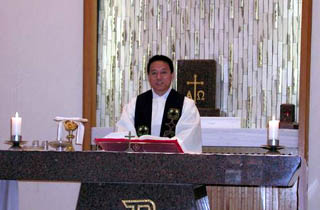 Catholic Unzen Church priest Fr. Kaoru Furusu
Catholic Unzen Church priest Fr. Kaoru Furusu
Between 1612 and 1658, at the Shimabara Peninsula, over tens of thousands of Christians had martyred themselves. Martyrs, are those who willingly gave their lives for God and people. They are people who did not lose their goodness or generosity, amidst a turbulent society and a life of poverty. The lives of those people will not be forgotten.
As the times were about to change, the world was on edge, and both adults and children were crying out. It was being shaken from the core.
"In our century, the martyrs have returned. Many of them remain nameless warriors, and have given their lives in honor of God. Now is the time we must treasure their testaments."
(Pope John Paul II "As the Third Millennium Approaches")
We hope that those who visit Unzen and Shimabara find something concrete, and can begin on their path to true happiness.
Unzen martyrs and stained glass
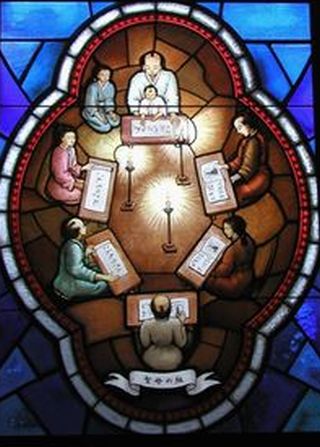
【Santa Maria Association】
The "Holy Mother Congregation Association" was an organization formed in Europe, still shaken from the Reformation, to train leaders of believers. In Japan, it is known as the "Santa Maria Association", and took shape of small community development through the education of believers. "Doctrina Christão (Teaching of Christians)" was the Church of Japan's first catechism, and was instrumental for the church to spread Christianity in absence of a priest. Furthermore, the "Konchirisan (Prayer for Absolute Contrition)" was recited, and was always recited during martyrdom and fumi-e. This collection of belief education and prayer were continued on during the persecution era in secrecy, and it is believed to be the reason for solidifying the faith of believers. "For where two or three are gathered together in my name, there am I in the midst of them." (Matthew 18:20) Believers will gather to learn and pray together, and the three candles that light their efforts signify that their efforts will take place under the Holy Trinity. In a time of darkness, God has shined a light upon those who were oppressed. The faces of those who saw God shine bright.
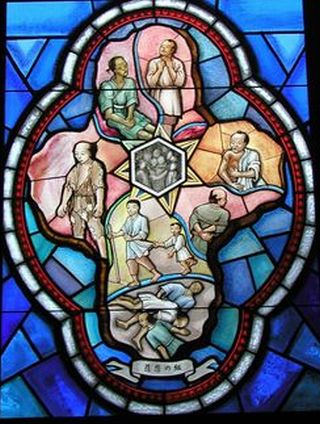
【Holy House of Mercy】
Christian gospels, spread by Francis Xavier, were passed down to poor Japanese people through Almeida, who was a missionary and doctor, as "God's mercy" through healing. Almeida formed and taught groups to practically carry out the words of the gospels, which laid the foundation for what would later become the "Misericórdia (Holy House of Mercy)". Their efforts, such as medicine, welfare activities, and helping the poor would reflect the "righteous men" in Matthew 25. In the "Doctrina Christão", there is a section on the Holy House of Mercy's "14 encouragements". On the stained glass, there are images depicting "7 encouragements regarding things and the body" (those who are hungry, those who are thirsty, those who have nothing to wear, those who are sick, those who are traveling, those who are captured, those who have passed away). "Be merciful, just as your father is merciful." (Luke 6:36). Through these teachings, Christian gospels were spread to poor Japanese people without reason, not because of righteousness, but through mercy.
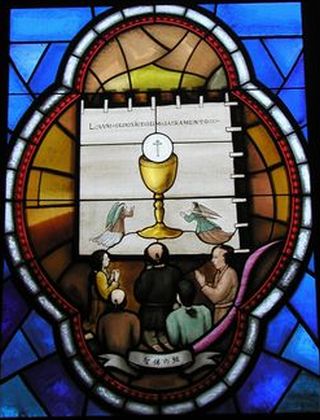
【Communion Association】
It is unclear how or who started it, but the activities of believers calling themselves the "Communion Association" appeared in the annual report from around 1610. Particularly, when the persecutions began, by preparing Eucharist worship and communion, they would encourage fellow believers and supported them. At the Shimabara Peninsula, it is reported that the martyrs were told to pray "praise the Eucharist". Furthermore, from the battle of Shimabara, there have been discoveries of flags of the Communion Association (battle flags of the Battle of Shimabara) and skulls of people whose heads were cut off with medallions in their mouths, showing proof of believers related to the Eucharist. It was Bishop Ignatius who preached the strong connection between the Eucharist and martyrdom, who later martyred himself in Rome, and it is thought that Japanese believers had the same spirituality. The reasons why Christians lived and died the way they did is the Eucharist. "The Misa is the source and the pinnacle of Christians." ("Dogmatic Constitution on the Church") On the stained glass, representing the flag of the Communion Association, there is a depiction of believers and angels in prayer in front of Ostia and Charis. It represents people receiving bread from God, as well as the decision of the people to become like Christ because of his sacrifice.
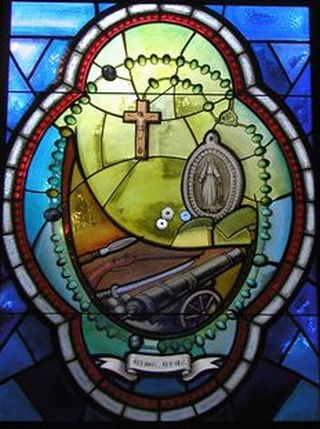
【The Sword to A Spade, The Spear to A Sickle】
The above three movements by the church represents the three missions (prophet, king, priest) of Jesus the Messiah (Christ, The Anointed One). In any era, these are the basics of the church, and by maintaining a balance of teaching, caring, and praying, the church reaches the same height as Christ. In the age of martyrdom, the churches in Japan remain as a symbol of their growth. The rosario beads, medallions, and crosses still being discovered today at Hara castle ruins, the bloody battleground for the battle of Shimabara, are believed to be made by Christians who held up indoors out of cannonballs and bullets.
They have transformed tools of war to tools of prayer, tools of killing to tools of peace. "And they shall beat their swords into plowshares, and their spears into pruning hooks" (Isaiah 2:4) Prophecies from God are truth. However, before reshaping cannonballs into rosario beads, there was a being who changed Christians from Adam's children to God's children. The rosarios are an "intermediate" form of prayer to that being. "His mother said to the servants, "Do whatever he tells you." (John 2:5) The role of the Holy Mother is to be an intermediate for the one who changed water into wine. Christ through Mary, presented change as "passover". The lead rosario beads are a symbol of "passover" left by the church in the age of martyrdom.
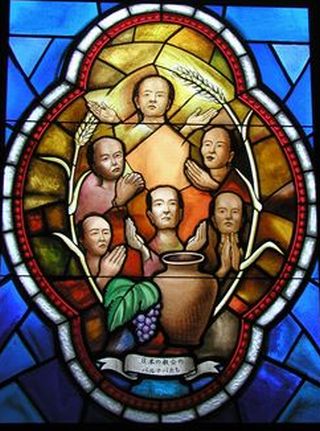
【Japanese Churches】
Rarely are there churches that have been raised by the believers such as the churches in Japan. Especially how the church remained intact without a priest for 250 years is definitely thanks to the work of something supernatural, but it was also proof that a church can survive only with its followers. However, the existence of specially chosen followers cannot be ignored. "Go into the city, and a man carrying a jar of water will meet you. Follow him." (Mark 14:13) "Joseph, a Levite from Cyprus, whom the apostles called Barnabas ("son of encouragement"), sold a field he owned and brought the money and put it at the apostles' feet." (Acts 4:36-37) From the days of the believers, as an act to protect them God chose a "son of encouragement". Those believers, who hid the missionaries, lead the believers, and protected the church with their own bodies, is definitely a loving child of God. From days of yonder to now, the Barnabas have supported the churches in Japan. Their lives are the grains of the bread of Christ, and their blood are like the grapes. The stained glass represents the Barnabas of the churches in Japan, and depicts the faces and praying hands 6 martyrs of Unzen, now applying for beatification.
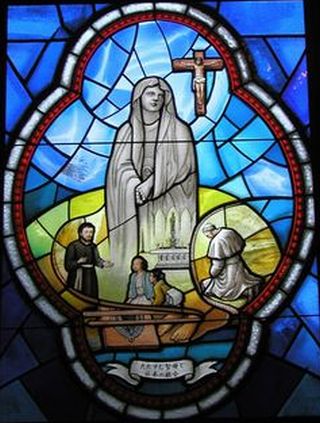
【Standing Virgin and Churches of Japan】
"And to the disciple, 'Here is your mother.'" (John 19:27) The crucified Christ gave upon us Mary as the mother of the church and the mother of those in suffering. Ever since, the Virgin Mary has been standing by those who are in suffering (Stabat Mater: Stationary Virgin, Sorrowing Virgin). During a silence of 250 years, Japan's churches did not have a single priest, yet the Virgin standing beside the cross silently was in sorrow. Not only was she beside the church, but also by the poor believers who would be faced with fumi-e year after year, chanting "Konchirisan" to repent their sins. In 1854, when the article of faith was announced for the Immaculate Conception, in 1858 the Virgin Mary appeared in Lourdes as if to confirm that. Through the missionaries of the Paris Missionary Association, who were affected by this Mary worshipping, God opened Japan's churches closed doors. The symbol (slogan) was "where is Santa Maria". Fr. Petitjean and Sugimoto Yuri, who represented the hiding Christians, reconfirmed their faith through the Virgin Mary. The Virgin Mary has been with the churches of Japan since Xavier's time. Furthermore, on August 9th, 1945, the US dropped an atomic bomb over Nagasaki, which exploded above the Urakami Cathedral. When this happened, the hands of the statue of the Virgin Mary standing by the cross were blown off. Even then, the Virgin Mary silently stood by those who were in suffering. "In 7 generations, the Pope will come from Rome". This prophecy, told among the hiding Christians, came true through Fr. Petitjean. On February 26th, 1981, Pope John Paul II came to this land, and prayed for the churches of Japan in front of the Virgin Mary.
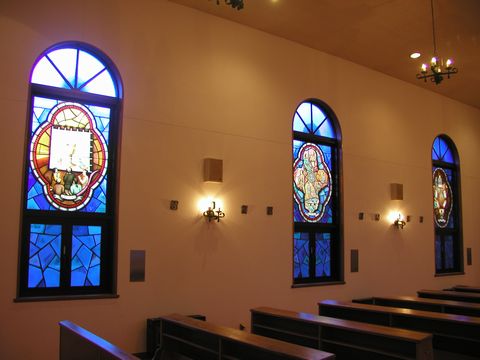
Every week on Sundays, from 11 AM, a mass takes place.
Please feel free to join.
Every day, from 9AM to 5PM, the stained glass is available for viewing.
